Email Notifications
Ability compliance training system includes automated and scheduled email notifications. These are typically system-wide emails with default language. Others can be developed upon request and approval. A small fee may be charged to support development and maintenance of special programs.
To Learners
Certain actions taken in Ability can trigger an immediate notification, such as registering for scheduled event, cancelling a registration, moving up the waitlist. Trainers can also initiate emails to all learners enrolled in their scheduled event, such as rescheduling or cancellation of an class or change of venue.
Several notifications are sent in batches at scheduled times (examples below).
-
Training Due within x Days
Sent to learner for new track assignments 30, 14, 7, 3, 1 days prior to due date.
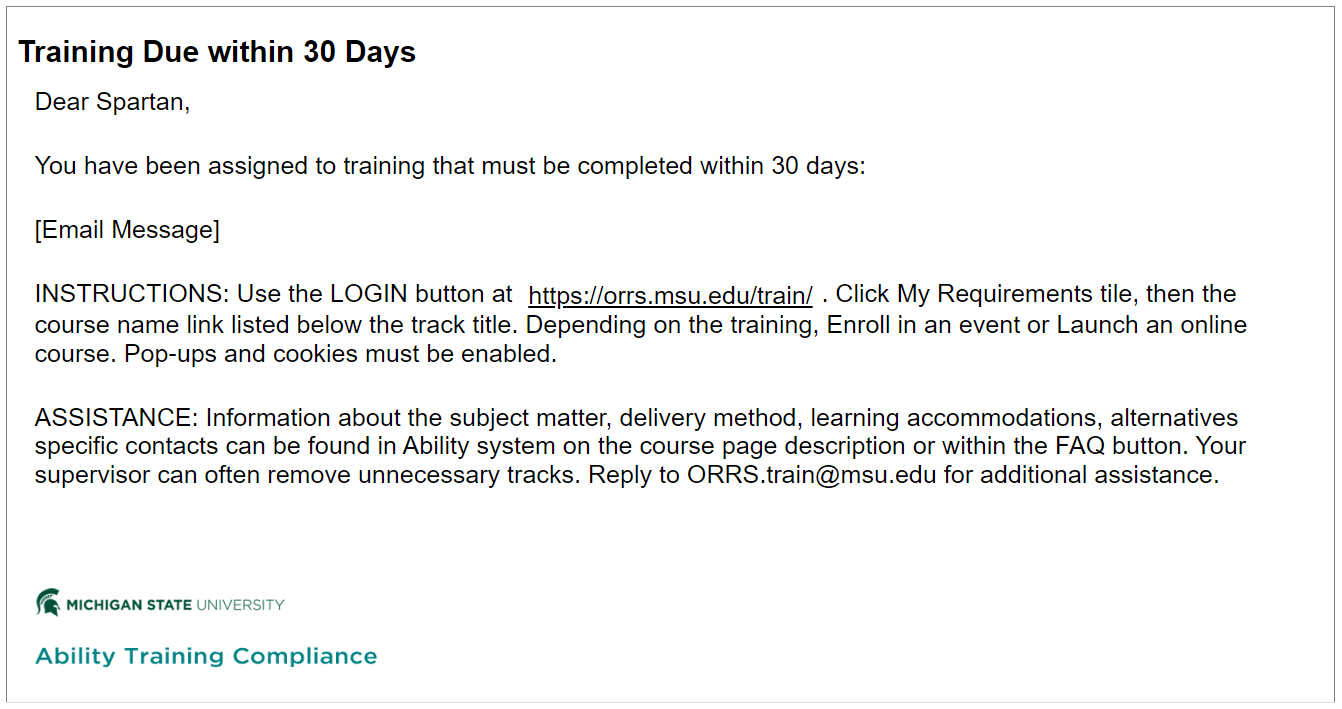
-
Training Past Due
Sent to learner for new track assignments 3, 30 days past due date.
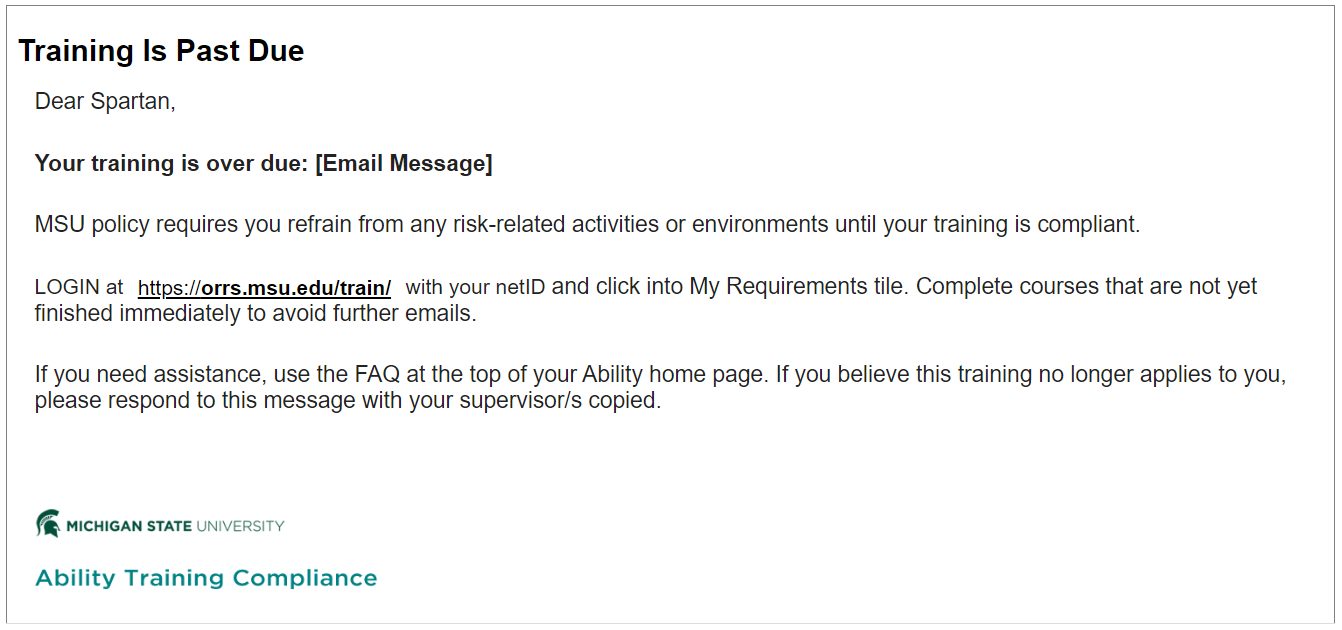
-
Training is Expiring
Sent to learner for recurring training requirements 30 14, 7, 3, 1 days prior to training expiration.
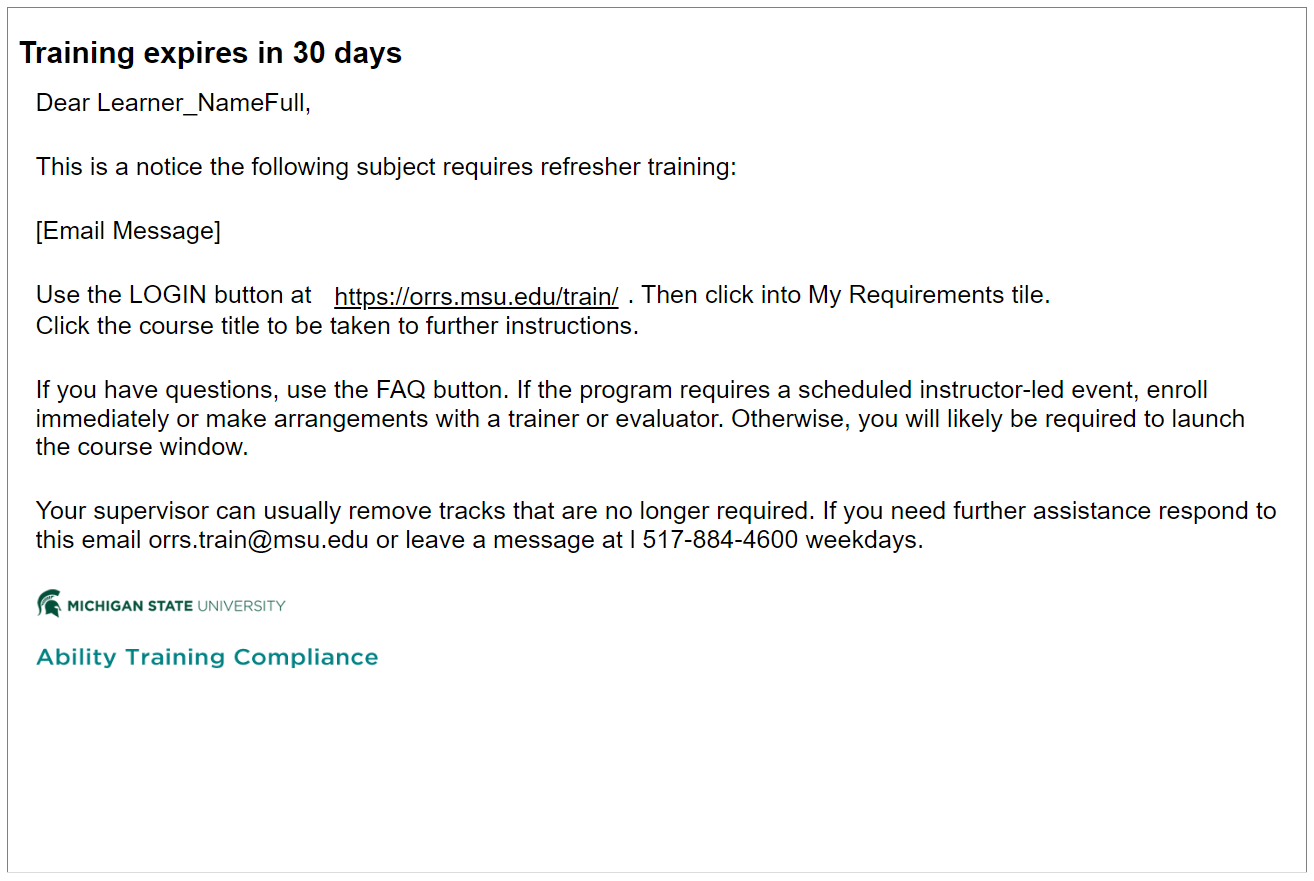
-
Training is Expired
Sent to learner for recurring training requirements 3, 7, 14, 30, and 60 days past training expiration.
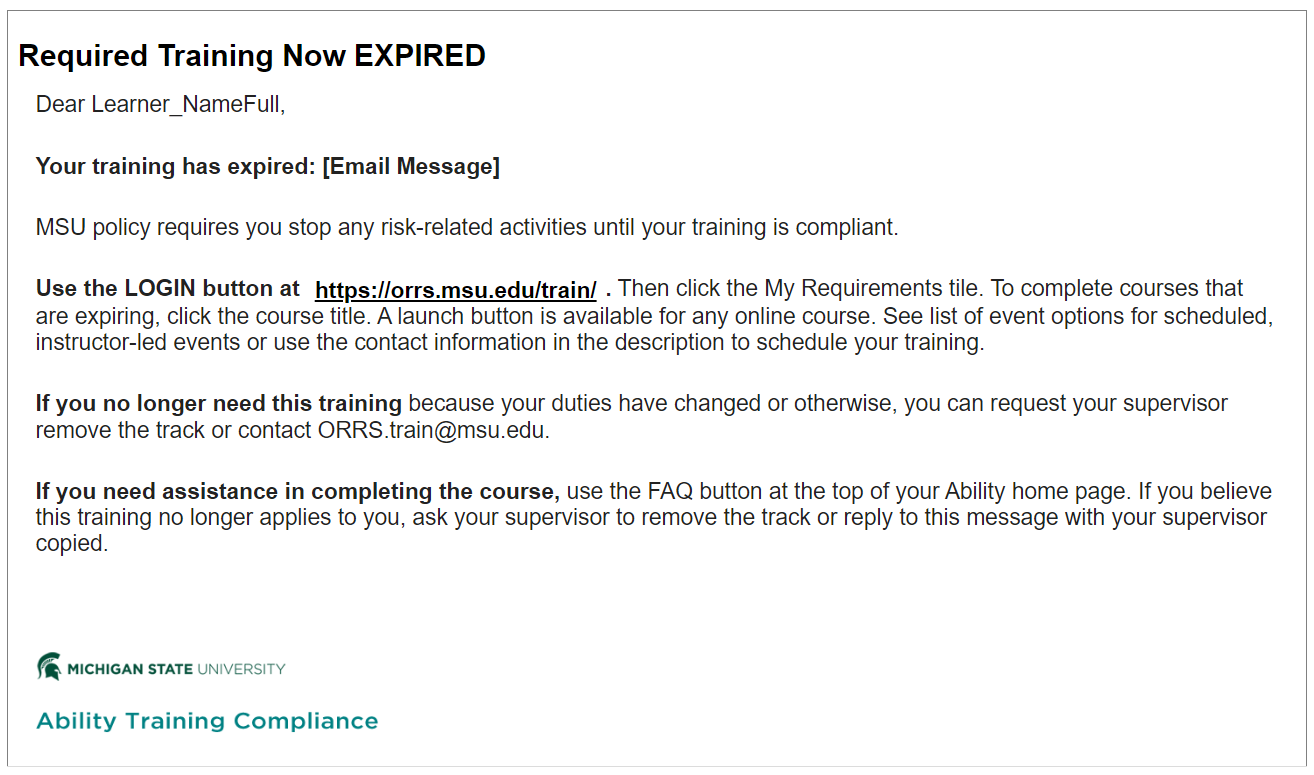
-
Enrollment Reminder
Sent to learner enrolled in virtual or in-person training 3, 1 days prior to event. Enrollment in online courses does not trigger notifications.
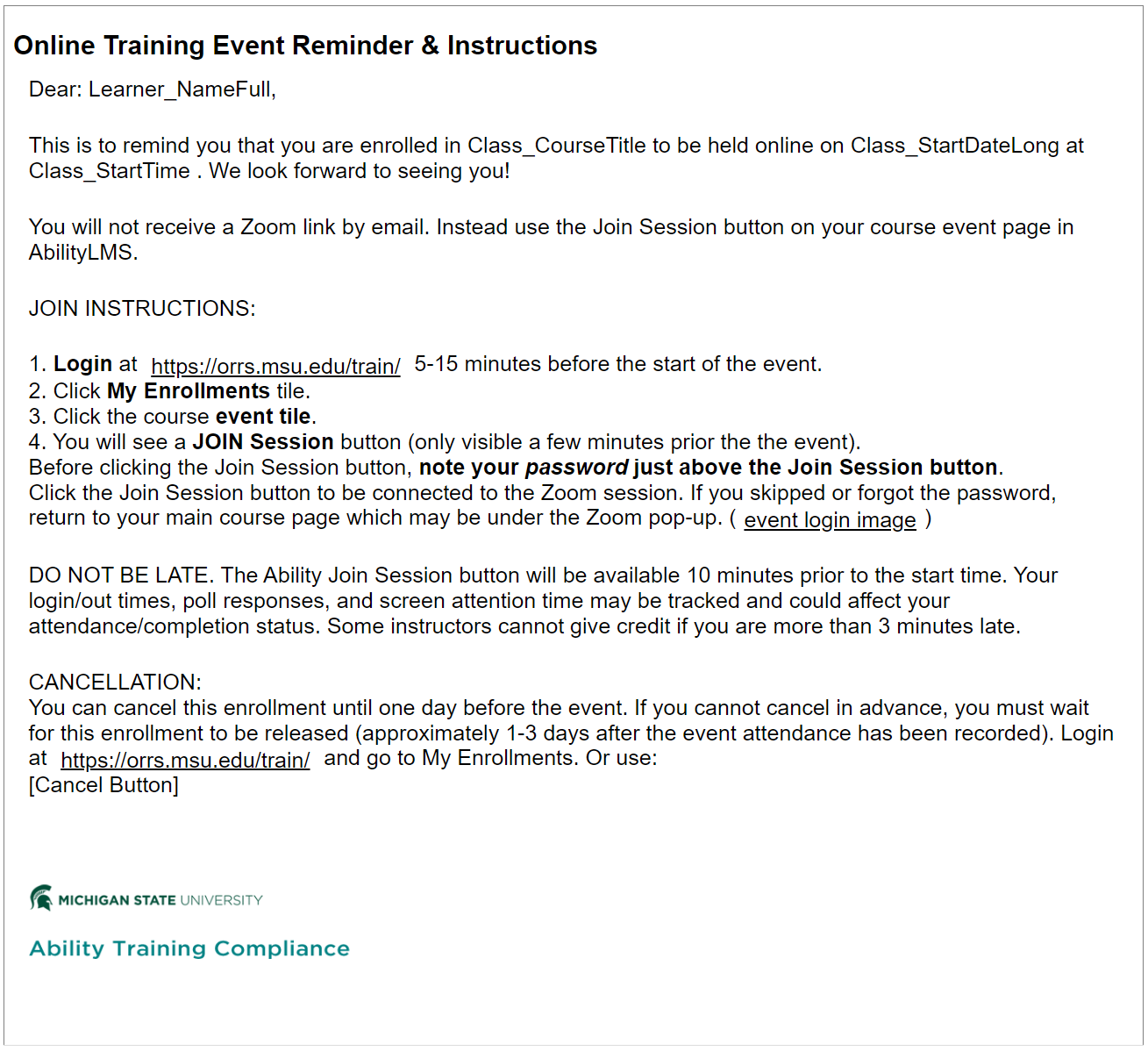
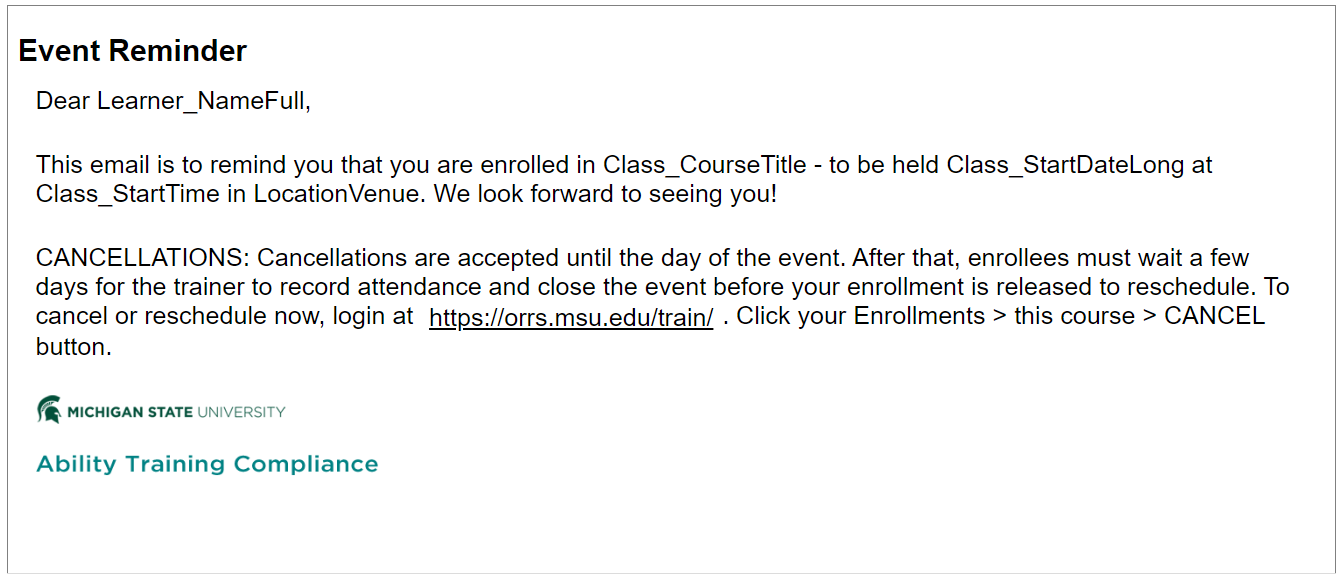
To Managers
Managers receive a weekly Monday Manager Report.
Noncompliance Email Notifications
-
How Schedule Was Decided
MSU's compliance training system email policies were developed with input from an anonymous survey, conversations with internal compliance staff and conversations with other training organization leaders within eLearning Guild, Saba LMS User group, Trivantis User group, our new vendor MaxIT and review of blog posts on the subject, as well as related research findings.
While research indicates that reminders do prompt many people to do their training, there is still not a definitive evidence of what is the most effective schedule for email reminders. Consider:
- Sent too near the due date, a recipient may not have time to react (received over the weekend, received while on vacation, received while on sabbatical).
- Sent too far in advance of the due date, recipients may ignore as there is no sense of urgency. If sent regularly too far in advance, it may even train recipients to procrastinate as "There will probably be additional reminders later."
- Sent too frequently, recipient can become further desensitized to your emails; training them to ignore most of their notifications.
-
Admitted Limitations of Email
Notifications Are One Variable to Compliance
No email reminder policy will solve all compliance problems. There are many other variables impacting compliance. Some escalation will be needed for a set of trainees. Compliance personnel receive conflicting feedback:
- Some managers complain they should have been informed about their subordinate's training status earlier.
- Some managers complain they receive too many email notifications about their subordinates.
- Some recipients of emails do not understand the email. It was too complicated.
- Some recipients complain that an email did not provide enough detail.
Best practicesWe strive to keep emails useful with these practices:
- meaningful subject lines including any action due date,
- scannable headings, using optional links, consistent terminology, short sentences, short words, and
- using multiple proof-readers of varying background knowledge prior to sending.
- trying to find a balance between changing text based on feedback, and keeping the text consistent to save the readers time in handling repeated emails.
It can be difficult to craft the wording of emails because:
- There are many types of training programs and training can be in several states with different screens for each trainee.
- Busy recipients only read the first sentence or scan the text.
-
Literature Review
The research below is strictly focused on the effects of emails. There is no definitive answer to what is the right number of emails. Adding more email reminders may improve training completion rates for some people. Too many emails may desensitive some people causing them to ignore or mark as spam.
For a more comprehensive understanding the impact of reminders, review the criminal justice, sociology, and psychology bodies of knowledge on cooperation, conformance, motivation, culture and group norms, time-management, complacency-urgency perception, etc.
Email reminders improve attendance at doctor’s appointments
Non-attendance rates in out-patient clinic went from 31.3% to 23.1% with addition of an email reminder of appointment. The main reasons for non-attendance given by patients were forgetting the appointment, practice error and a mix-up over dates. Known risk factors for non-attendance include younger age, male gender and distance from appointment. [i] A single SMS reminder for outpatient appointments also significantly reduced missed appointments rate, although it varies by clinic speciality.[ii]
Postal mail reminders to refill prescriptions improve refill rates
In the reminder group 19.6% complied with all medications refills compared to 18.0% in the control group, not a significant difference between the groups. In the reminder group 39% complied with cardiovascular medications refills compared to 14% in the control group, a significant difference between the groups.[iii]
Email reminders effective at increasing access to optional training.
Reminding physicians often via email about online educational opportunities appears to increase engagement in a community-based primary care physician audience. Persistent email reminders did increase physicians' response rates to online education, but response rate decreased with the number of reminders.
Women were significantly more responsive than men.
The first three reminders produced the largest responses.
Highest response (logins) were Mondays, 3-7:00 pm.[iv]
Wording impacts effectiveness of email reminders
Recipients of simplified versions of an email (versus those receiving longer version), were more likely to take action (23% more likely). Some information increased action further (exact size of financial benefit) and some information had no effect (how much time the effort/application would take).
Monthly SMS reminders from the bank increased total amount saved by 6%, but reminders mentioning the users’ savings goals (e.g. boat, school) were twice as effective.[vi]
Several studies conducted on impact of ‘warm’ messages versus ‘cold’ (impersonal) wording range from improving effectiveness from 9-18%. [vii]
Getting the audience to take any step, increases likelihood of more compliance
If you can get someone to agree to some small item, they are more likely to continue to comply with a next greater demand (versus asking them to just comply with the single greater request). Research indicated it "primed-the-pump" to ask for a small, simple request first, almost like establishing a path or habit for the person to say "yes" to the next request. Asking someone to take a minute to "register" for training increases chance person will then begin an online course or attend an event later. [viii]
References
[i] Effectiveness of reminders in reducing non-attendance among out-patients. Mahesh Rajasuriya, Varuni de Silva, Raveen Hanwella. Psychiatrist (Dec 2010) 34: 515-518(34):515-518.
[ii] Effectiveness of text message reminders on nonattendance of outpatient clinic appointments in three different specialties: A randomized controlled trial in a Saudi Hospital. Yousset, A. et al. Journal of Taibah University Medical Sciences; vol 9, Iss 1, March 2014, p 23-29.
[iii] Effectiveness of a computer-supported refill reminder system, Baird, TK et al. Am Journal Hosp Pharm, 1984 Nov, Vol 41:11.
[iv] Using email reminders to engage physicians in an Internet-based CME intervention. Abdolrasulnia, et al, BMC Medical Education, 29 September 2004.
[v] Bhargava, S & Manoli, D. (2013). Why are benefits left on the table? Assessing the role of information, complexity, and stigma on take-up with an IRS field experiment. Amer. Econ. Rev.
[vi] Dean Karlan & Margaret McConnell & Sendhil Mullainathan & Jonathan Zinman, 2010. "Getting to the Top of Mind: How Reminders Increase Saving," NBER Working Papers 16205, National Bureau of Economic Research, Inc.
[vii] Malhotra, N., Michelson, M. R., Rogers, T., & Valenzuela, A. A. (2011). Text Messages as Mobilization Tools The Conditional Effect of Text Messages as Mobilization Tools The Conditional Effect of. American Politics Research, 39(4), 664-681.
[viii] Freedman, J.L. & Fraser, S.C. (1966). Compliance without pressure: the foot-in-the-door technique. Journal of personality and social psychology, 4(2), 195.

